Today, organizations use various third-party recognition platforms to appreciate their employees’ excellent work and achievements. However, a few organizations still rely on employee rewards and recognition tools developed internally. In this article, we look at why these organizations should consider switching from such in-house employee recognition platforms to third-party platforms.
Understanding why organizations choose internally developed tools for employee rewards and recognition is essential.
Many of them continue to use them despite the availability of advanced employee recognition platforms in the market.
So, let’s look at the top reasons for preferring an in-house system over a third-party employee recognition platform:
1. Need for Greater Customization
2. Need for Greater Control over the Product Roadmap
3. Data Privacy and Security Concerns
4. Need for Internal System Integration
5. Better Cost Management
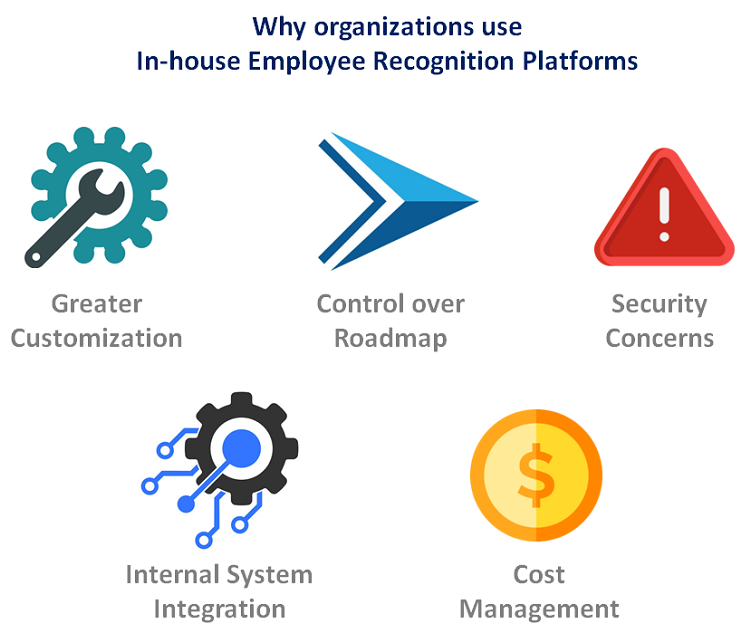

An in-house employee recognition platform is often specifically designed to meet the unique recognition needs of the organization.
The tool matches the exact requirements of the organization from the perspective of the recognition process.
The tool also accurately incorporates the workforce’s expectations in terms of the user experience.
Typically, organizations would look at their immediate and medium-term needs while developing such platforms internally.
They would have also found it challenging to identify third-party recognition platforms that would have provided the exact features or offered the required level of customization at that time.

Having an in-house rewards and recognition system provides greater control for the organization. It gives them full control over the design, implementation, and administration of the program.
Most importantly, they can make modifications to the program as and when they want.
They can incorporate those changes in the in-house recognition platform without significant delay.
This is often not the case with third-party platforms, as the control over the product roadmap rests with the vendors rather than the organizations using the software.

One major reason organizations feel skeptical about using a third-party recognition platform is concerns about the safety and privacy of their business and employee data.
With in-house employee recognition platforms, organizations can maintain strict control over how and what data they collect, store, and transmit.
They also use stringent data privacy and security policies and measures to prevent misuse.
Due to security concerns, many organizations are uncomfortable with third-party vendors that use cloud-based applications and store employee data in the cloud.

Organizations with in-house R&R systems design them so that they can be easily and directly integrated with other systems used in the workplace. This integration can help streamline and improve the recognition process.
In-house systems can be deeply integrated with internal platforms in a way that might be difficult in the case of third-party systems.
Organizations are well aware of the challenges of integrating these in-house systems with third-party platforms provided by vendors.

Usually, an in-house R&R tool can be more cost-effective in the long run despite the high initial investment and effort.
This is because third-party recognition platforms often charge hefty monthly or annual subscription fees based on the number of users.
As the headcount grows, the costs are likely to grow significantly. Moreover, the vendor might also charge for even small changes or modifications to the platform.
Organizations typically develop the platform through in-house IT resources or outsourcing it to IT service companies.
While the initial development costs might still be significant, the maintenance costs might be nominal and do not increase with the headcount.
Hence, an in-house R&R system might prove to be a more cost-effective option than third-party recognition software.
While organizations may initially see several advantages to in-house rewards and recognition tools, they have significant disadvantages in the long run.
So, here are the key disadvantages of using in-house R&R tools:
1. Difficult to Leverage Best Practices
2. Difficult to Maintain
3. Difficult to Upgrade
4. Difficult to Scale
5. Inadequate Redemption Options
6. Poor Integration with Social Media and Cloud Apps
7. Lack of Mobile Apps
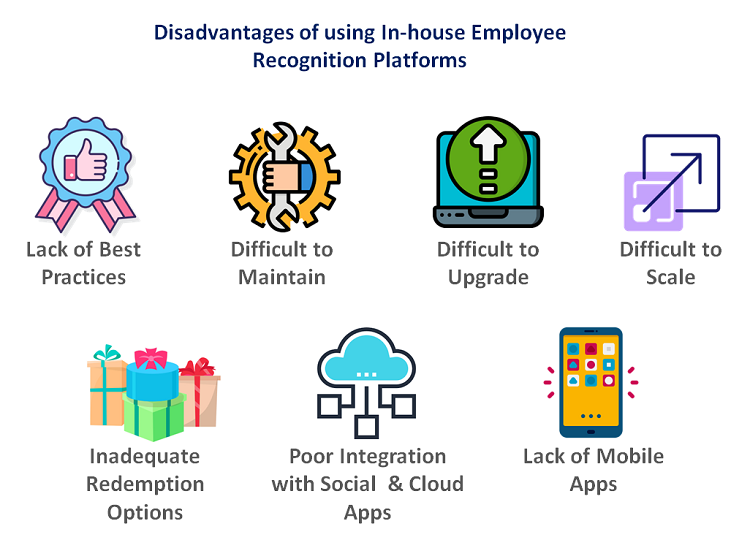

Typically, an in-house recognition platform focuses only on the organization’s specific needs in the immediate and medium term.
Hence, it might not incorporate features that reflect the best practices of employee recognition such as gamification and social integration.
Hence, the lack of such advanced features can limit the effectiveness of the recognition program.

Maintaining and updating the in-house recognition system often requires expert resources, which may not be readily available internally or too expensive to hire.
This directly impacts the ability of the organization to keep the system functioning at a high level of efficiency.
It might lead to a drop in system availability and performance, which can negatively impact the recognition program’s user experience and process flow.

The organization might often find it challenging to upgrade the in-house recognition platforms regularly. This may be due to constraints of resources, budgets, or expertise.
The business requirements based on which the platform was developed might change over time.
However, since the platform is not upgraded to keep up with the changes, it might not meet the current requirements and expectations of the organization and the workforce.
Also, the technology used for development might have become outdated over time. Hence, the platform might not work as efficiently as required.
This may also negatively impact the recognition program’s user experience and process efficiencies.

Not only the business requirements might change over time; there might be a significant increase in the headcount of organizations and the number of work locations.
These changes substantially increase the workload on the in-house platform and the infrastructure used.
Since most in-house systems are not designed to handle higher volumes of data and transactions, this may lead to a deterioration in the performance and availability of the platform over time.
A significant number of employees working remotely might further compound the problem, as they might be using lower-bandwidth network connections.

Most in-house recognition systems often lack sufficient and meaningful redemption options such as a wide selection of gift cards and merchandise.
Usually, these programs offer a single brand of gift cards or a limited merchandise set.
Logistics and delivery of merchandise might also pose a challenge if not outsourced and coordinated correctly.
Hence, the employee experience can be impacted negatively as employees might not have enough freedom of choice or access to preferred brands and products.

Social media integration has become a must-have feature for any successful recognition system. However, most in-house systems often lack this critical feature.
This makes it cumbersome for employees to share their rewards and recognition on social media platforms such as LinkedIn and Facebook.
Integration with other popular cloud-based applications, such as Slack, MS Teams, Workplace, etc., might also be challenging for in-house recognition platforms.
The lack of such features further dents the employee experience as enough social buzz cannot be created around the recognition program.
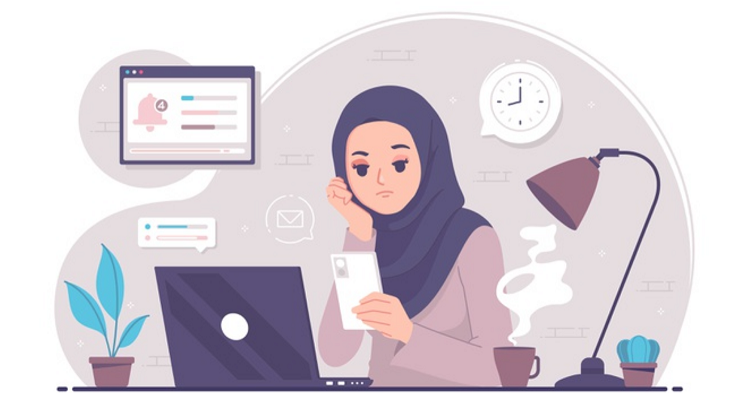
Mobile apps are essential elements of an employee recognition platform. They allow employees to use the platform on the go.
Most employees are habituated to using mobile applications for personal and professional activities.
However, in-house recognition systems very often do not provide the facility of mobile apps.
This can prove highly disadvantageous for organizations, as it can reduce the employee participation rate and eventually limit the program’s impact.
Despite the initial advantages of using an in-house platform for employee recognition, its effectiveness typically deteriorates over time as the organization grows and evolves.
The business requirements change and the headcount increases, making it difficult for the in-house platforms to cater to the changing needs of the organization.
Third-party employee recognition platforms offer significant advantages to organizations, especially in the long run. So, let’s take a look at what they bring to the table:
1. Advanced Out-of-the-box Features
2. Higher Level of Configurability
3. High Level of Reliability and Scalability
4. Robust Data Security Features
5. Availability of Experts
6. Flexible Pricing Models
7. Vast Redemption Options
8. Availability of Mobile Apps and Integration Options


Good third-party employee recognition platforms offer a host of high-end, out-of-the-box features, such as gamification, analytics and insights, and social integration.
These features can drive employee engagement and significantly enhance the impact of the recognition program.
Also, newer versions of these platforms are released regularly, that come with new and innovative features that represent the evolving best practices from the industry.
These help drive the employee experience and build excellent traction in the recognition programs.
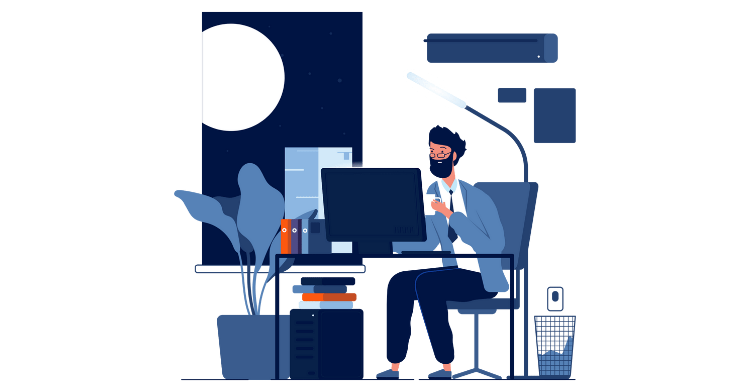
Organizations often opt for in-house recognition platforms to meet their specific needs. However, today, good off-the-shelf recognition platforms offer a high level of customization to accommodate various use cases.
These platforms provide features that can be easily configured to match the exact scenarios and processes for each organization.
In the case of in-house platforms, it saves significant time and effort to build such features from scratch.

Third-party recognition platforms are much easier to scale up for a large number of users and are likely to be more reliable than in-house platforms.
These off-the-shelf platforms leverage best practices of software engineering and high-end cloud infrastructure such as serverless architecture, load balancers, autoscaling, and content delivery networks.
These platforms also undergo rigorous functional and load testing to minimize the possibility of failures and service disruption. Also, adding new users with increasing headcount becomes a seamless process.
It doesn’t require significant system architecture and infrastructure changes as needed for an in-house platform.
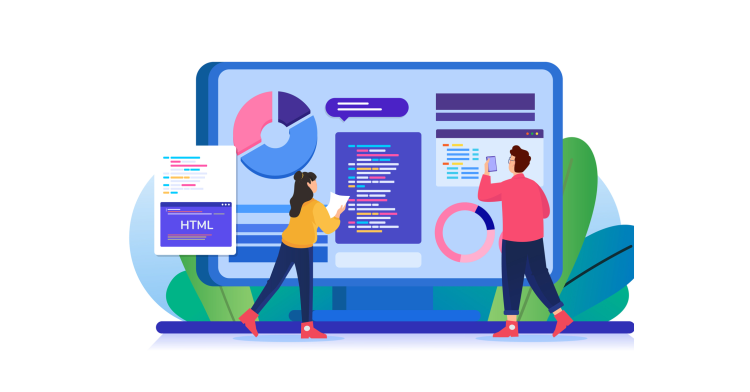
Most well-known third-party employee recognition comes with advanced security features such as application firewalls, encryption, multi-factor authentication, role-based access control, activity logging and monitoring, etc.
Accredited agencies often test and certify the security readiness of these platforms. These security measures also comply with major industry standards and regulatory frameworks.
Hence, these third-party platforms ensure the same or even higher levels of data security compared to in-house platforms.

Most recognition platform vendors have a team of technical and functional experts who design, develop, maintain, and upgrade those platforms.
These experts ensure that the technology, system architecture, and infrastructure are up-to-date and in sync with the changing business requirements.
The functional experts develop the product roadmap with regular enhancements and the release of new features.
They also help and guide client organizations in incorporating these new features into their recognition programs, thereby improving the employee experience and the programs’ impact.

Most recognition platform vendors charge low or no upfront fees. This makes it easier for organizations to switch from in-house platforms.
Also, several vendors offer different pricing models such as pay-per-use and tiered pricing. This ensures that the per-employee cost reduces as the headcount increases.
Other options, such as feature-based and fixed pricing, might also be available.
The availability of multiple pricing models enables organizations to select the most appropriate one, taking into consideration various factors such as current headcount and projected headcount growth.

Third-party recognition platforms come with in-built catalogs for redemption, which include a vast number of options such as gift cards of multiple brands and a curated selection of merchandise.
These platforms are also tightly integrated with logistics platforms that ensure seamless delivery of the items.
These platforms provide employees extensive freedom of choice, including well-known and popular gift card brands and products. Hence, they provide excellent end-user experience and engagement for the employees.

Most third-party recognition platforms offer mobile apps for both Android and iOS devices.
This enhances the employee experience and engagement as they can use the platform anytime, anywhere.
Also, good recognition platforms offer a whole host of integration options with social media platforms and popular cloud-based platforms used in workplaces.
These include collaboration tools, HRMS, CRM, Learning Management Systems (LMS), and Project Management tools.
They also enable single sign-on options with Office 365 and Google Workspace platforms.
These built-in integration options can help make the process flow across different workplace systems seamless and, thus, improve the employee experience.
In most cases, switching to a third-party employee recognition platform from an in-house platform can prove beneficial for the organization in many ways. However, it is important to do enough groundwork to identify and select the right employee recognition platform that can cater to the specific needs of the organization.

Lead author: Sagar Chaudhuri, the Co-Founder and CEO of HiFives. He is an HR Tech Evangelist with over 25 years of corporate and entrepreneurship experience. In the past, Sagar has worked in leadership roles with companies such as Genpact, Infosys, and ICICI Bank. He has an engineering degree from IIT Kharagpur and an MBA from IIM Lucknow. Connect on LinkedIn
To stay updated on the latest HiFives blogs, follow us on Twitter (@MyHiFives)